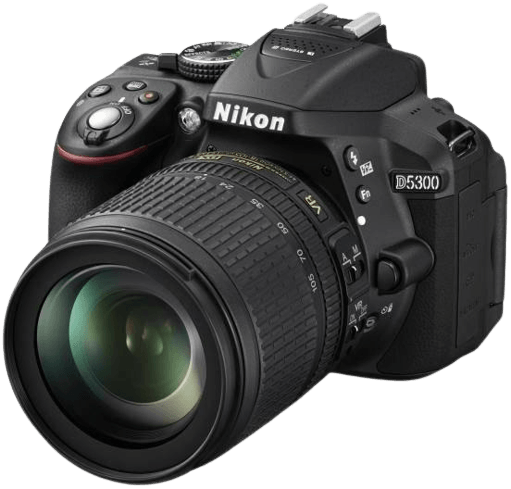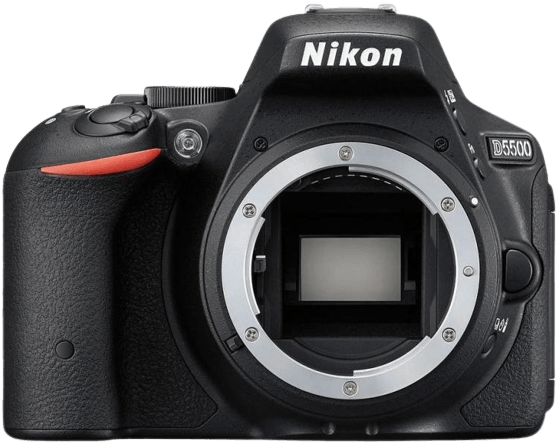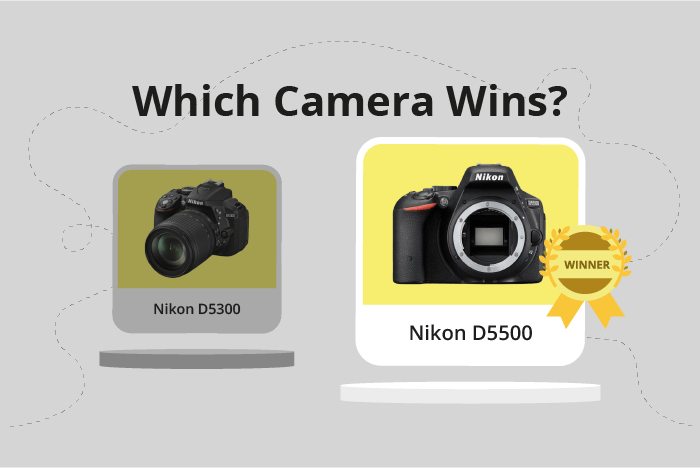Nikon D5300 vs D5500 Comparison
Nikon D5300

Nikon D5500

The Nikon D5500 takes the lead with a score of 61/100, while the Nikon D5300 follows closely with 57/100. Both cameras are DSLR models, released in 2013 and 2015 respectively, and share similar dimensions, with the D5500 being slightly smaller at 124 x 97 x 70mm compared to the D5300’s 125 x 98 x 76mm.
The winning D5500 is lighter at 420g, making it more convenient for on-the-go photography. However, the D5300 is more affordable with a launch price of $800, compared to the D5500’s $900.
Despite the slight difference in scores, both cameras offer unique advantages. The D5500 excels in portability, while the D5300 provides a more budget-friendly option. Ultimately, the choice depends on the photographer’s priorities and preferences.
Nikon D5300 vs D5500 Overview and Optics
The Nikon D5300 and Nikon D5500 both receive an optics score of 65/100, indicating that they have comparable optical performance. Both cameras feature 24.2 megapixels, a shooting speed of 5 frames per second, a CMOS sensor type, an Expeed 4 processor, an APS-C sensor size, a Nikon F DX lens mount, and no image stabilization.
The Nikon D5500 has a slight advantage with a DXOMARK sensor score of 84, compared to the D5300’s score of 83. This higher score means that the D5500 is capable of capturing slightly better image quality, particularly in terms of dynamic range and low-light performance. This difference, however, is marginal and may not be noticeable in everyday shooting situations.
On the other hand, the Nikon D5300 does not have any specific advantages in terms of optics. Both cameras share the same specifications, and the D5300’s lower DXOMARK sensor score does not provide any benefits over the D5500.
Given these findings, it is clear that the Nikon D5500 has a minor edge over the Nikon D5300 in terms of optical performance. The D5500’s slightly higher DXOMARK sensor score indicates that it is capable of capturing marginally better image quality. However, this difference is minimal, and both cameras are still quite comparable in their optical performance. Ultimately, the choice between these two cameras may come down to factors beyond optics, such as price, build quality, and additional features.
Nikon D5300 vs D5500 Video Performance
When comparing the video capabilities of the Nikon D5300 and the Nikon D5500, it is evident that both cameras are on par, as they both have a video score of 70/100. As such, there is no clear winner in this category. Both cameras share similar video specifications, allowing users to achieve similar results in terms of video performance.
The Nikon D5300 and D5500 both have a maximum video resolution of Full HD, with dimensions of 1920 x 1080. This ensures that the videos captured by both cameras are of high quality and clarity. Additionally, both cameras offer a maximum video frame rate of 60fps, allowing for smooth and seamless video recording. Furthermore, the time-lapse functionality built into both cameras enables users to create stunning time-lapse videos with ease.
Although the video capabilities of both cameras are quite similar, each camera may offer unique features or performance aspects that cater to different user preferences. It is essential for potential buyers to consider these differences and choose the camera that best suits their specific needs and requirements.
After examining the video capabilities of both the Nikon D5300 and D5500, it is clear that they are equally matched in this aspect. Both cameras offer high-quality video recording with Full HD resolution, smooth frame rates, and time-lapse functionality. Users can expect similar video performance from either camera, making the choice between the two a matter of personal preference and other factors such as price, build, and additional features.
Nikon D5300 vs D5500 Features and Benefits
The Nikon D5500 wins in the features comparison with a score of 59/100, while the Nikon D5300 has a score of 46/100. Both cameras share some similar specifications, such as a 3.2-inch screen size, a screen resolution of 1,037,000 dots, flip screens, WIFI connectivity, and no Bluetooth.
The Nikon D5500 stands out due to its touchscreen capability. This feature allows users to navigate through settings, adjust focus points, and review images with ease. Touchscreen functionality improves the overall user experience and makes the camera more intuitive to operate.
On the other hand, the Nikon D5300 has a GPS feature that the D5500 lacks. GPS enables users to geotag their images, which can be helpful for organizing and tracking the location of photos. This feature may be beneficial for those who travel frequently and want to document their journeys.
In comparing the two cameras, the Nikon D5500 proves to be a better choice for most users due to its touchscreen functionality. The touchscreen simplifies the camera’s operation and makes it more user-friendly. However, the Nikon D5300’s GPS feature may appeal to a niche group of users who prioritize geotagging capabilities.
When considering which camera to purchase, it is essential to weigh the importance of each feature to your specific needs. The Nikon D5500 offers a more streamlined user experience, while the Nikon D5300 provides unique GPS functionality.
Nikon D5300 vs D5500 Storage and Battery
The Nikon D5500 outperforms the Nikon D5300 in storage and battery, scoring 35/100 compared to the D5300’s 29/100. Both cameras share similarities, such as having one memory card slot and accepting SD, SDHC, and SDXC cards. Neither camera supports USB charging.
The D5500’s superior battery life sets it apart, offering 820 shots compared to the D5300’s 600 shots. Although the D5500 uses an EN-EL14 battery type, while the D5300 uses an EN-EL14a, the difference does not impact performance.
The D5300 does not have any advantages in storage and battery over the D5500. With a longer battery life, the Nikon D5500 proves to be better in this category, making it a more reliable option for extended photography sessions.
Alternatives to the Nikon D5300 and D5500
Are you still undecided about which camera is right for you? Have a look at these popular comparisons that feature the Nikon D5300 or the Nikon D5500:

